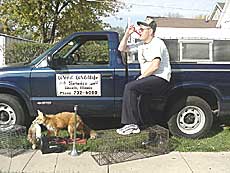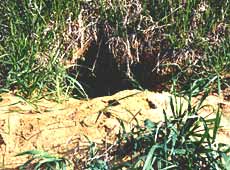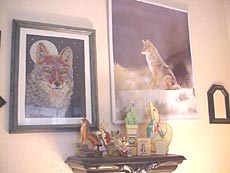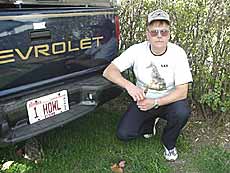|
Hooked
on coyotes
Lincoln man Les Wood is
"self-taught coyote
professional"
Part 3
[NOV. 8, 2000]
The
man who got Les Wood hooked on coyotes, Bill Austin, spent months
studying groups of coyotes in Wyoming. Austin concluded that the
animals were using 11 different basic calls to communicate with each
other. He and a wildlife scientist at the University of Colorado
recorded and identified these calls. Les regularly uses three of
them.
|
|
[click here for Part 1]
[click here for Part 2]
First
is the interrogation howl or lonesome howl: two quick barks and a long,
drawn-out howl. This call is asking, "Hello, is there anybody out
there?" If you say "hello" to a coyote, he will answer you, Les
says.

The
second call is the challenge call, which is one answer to the interrogation
call. It is two quick barks and two short howls. It says, "If you donít
leave my territory, Iím going to come and fight."
The
third is the injured pup call, a yipping sound like you hear when you step on a
dogís foot. Coyotes are so protective of little ones they will come the first
time they hear the injured pup call. But if they come back a second time and donít
find a pup there, they wonít be fooled again, Les says.

At
any time, coyotes are hard to fool. "Youíve got to work to outsmart them.
You see them run in one direction, you jump in your vehicle and drive around to
catch up with them and they arenít there. When you locate their tracks, you
find they have figured out what you were doing, doubled back on you and gone the
other way."
For
Les, a big part of the appeal of coyotes is trying to outmaneuver a very clever
animal. "If you can fool one with a vocalization and get him into camera or
gun range, itís very exciting."

[This orange coyote call is one of Les's favorites. He can also amplify
it or use it with a remote control device.]
To
fool them with vocalizations, Les practices his coyote calls just as he would a
musical instrument: sitting at his kitchen table, listening to tapes, then
trying to reproduce the sound on one of his many coyote callers. The callers,
once made of wood but now mostly PVC plastic, have a reed to make the sound and
barrel extensions to alter it. Les also uses a megaphone to make the calls
louder and even has an electronic caller that operates by remote control,
letting him get about 200 yards away from the site where the sound is coming
from.
[to
top of second column in this section]
|

He
sometimes uses lures, like a stuffed red fox with a rabbit in its
mouth or a deer fawn. Coyotes donít like foxes and will run them
out of their territory. Les would never use a deer fawn lure in
winter, because coyotes are smart enough to know there are no fawns
then.

[Les Wood's tackle box holds his collection of coyote
callers. He practices them as he would a musical instrument.]
Les
may also try to mask his scent by using skunk scent as a cover. He
puts the scent, which he purchases, on a cotton ball in a container
next to him. It masks the human scent at least for a time, although
when the coyote gets close in he can smell the human through the
skunk odor.

For
his nuisance animal control business, Les has to keep records for
IDNR of every animal he traps. Heís also typing into his computer
all the information heís learning about the elusive coyote,
information which will someday end up in another article or maybe
even a book.
Les
agrees with a Native American legend that says the coyote is so
clever he will be the last surviving animal on earth. "I think
it could be true. The more coyotes you take out of an area, the
faster they breed to replenish themselves. And they are extremely
adaptable. You will never completely get rid of coyotes."
[Joan
Crabb]

|
|
ILLINI
BANK
2201
Woodlawn Rd. in Lincoln
1-888-455-4641 or 735-5400
Ask for Terry Lock or Sharon Awe Ask
about our 7% APY CD
7 mo. - $5,000 minimum |
Our
staff offers more than 25 years of experience in the
automotive industry.
Greyhound
Lube At
the corner of Woodlawn and Business 55 No
Appointments Necessary |
Meador
Investigations
Ė michael@pi-pro.com Ė
217-376-3255
IL
License # 115-001499
Click
here to visit your local Private Investigator
www.pi-pro.com
|
|
|
|
Hooked
on coyotes
Lincoln man Les Wood is
"self-taught coyote
professional"
Part 2
[NOV. 7, 2000]
Les
Wood likes to talk about coyotes. Heís learned a lot about them,
which helps him in his business of wildlife nuisance control. Heís
also learned to respect this intelligent animal that can make its
home just about anywhere.
|
|
[click here for Part 1]
The
coyote, one of the most clever and adaptable animals in nature, is a close
relative of the wolf and the dog. Once thought of as a Southwestern animal, it
has been steadily expanding its range and can be found today in New York City,
in the Canadian wilderness, in the middle of Death Valley and high in Coloradoís
Rocky Mountains. It has keen hearing and a sense of smell at least 100 times
better than a human being has. Although it cannot see color, it has excellent
night vision. Also, it will eat just about anything.

[A stuffed red fox holding a rabbit helps attract coyotes. Les
uses only live traps to capture nuisance animals, including coyotes.]
Weighing
between 30 to 40 pounds, the coyote has yellowish gray fur, a bushy tail and
prominent ears. Les says it looks a little like a German shepherd but is smaller
than a shepherd or a wolf (wolves can weigh up to 300 pounds).

The
first time Les saw coyotes in Logan County was 1972, in a place called Polecat
Hill near Middletown. He believes there are at least 200 coyotes in the county
now, probably more. Itís hard to tell because when they "sing" at
dawn and dusk, three or four animals can sound like 30.
Coyotes
are highly territorial and social, and they use their calls to communicate with
each other. They hunt individually or in pairs and do not travel in packs unless
the winter is so hard they canít find food any other way except to "pack
up" and take down a large animal.

They
mate for life and take excellent care of their pups. If one of a
pair dies, other coyotes will help the remaining animal raise the
young ones. Mating is in mid-February, and pups are born in April or
May. The male coyote digs four or five dens for the female in the
fall, and when it is time for her to give birth, she chooses one of
them.
[to
top of second column in this section]
|

[A coyote den]
Like
wolves, they have a social "pecking order." The alpha male
and alpha female, the dominant coyotes in the group, eat first. The
others wait, tails curled under their bodies as a sign of
submission, until their turn comes. When the alphas have finished,
the other coyotes are allowed to eat.

Surprisingly,
a favorite coyote food staple is mice. "For the most part, they
are mousers," Les says. He describes a coyote in winter,
hunting mice in the snow: "It stands there alert, listening,
ears pricked, then it pounces. It can hear the mouse under the snow
and digs it out.
"They
also love rabbits and pheasants, and there are not too many stray
cats around now because coyotes like them, too," Les says.

[Pictures and statuettes of coyotes decorate his
home. The needlepoint picture on the left was made by Les' wife.]
"I
go out early in the morning or late at night to locate them. They
are nocturnal animals, and before they go hunting at night, they
have a Ďgroup howl session.í" Once he knows the general
area where the coyotes are living, Les uses his coyote calls to get
them to come to him.
(To
be continued)
[Joan
Crabb]
[click
here for Part 3]

|
|
Lincoln
Ag Center
1441 State
Route 10 East
Lincoln, IL
217-732-7948
We
support Lincolndailynews.com!
Click
here to visit our website!!! |
Blue
Dog Inn
111 S. Sangamon
217-735-1743
Open
for Lunch Mon.-Sat.
Open for Dinner Tues.-Sat.
Click
here to view our
menu and gift items |
25
Cents per
Gallon
Self-vendored
reverse osmosis water
The
Culligan
Fresh Water Station
318
N. Chicago St., Lincoln |
|
|
|
What makes him
howl!
Lincoln man Les Wood is
"self-taught coyote
professional"
Part 1
[NOV. 6, 2000]
Les
Wood is hooked on coyotes.
|
|
"Hardly
a day goes by that Iím not talking to somebody about coyotes," says the
Lincoln native. In his home are photos of coyotes, statuettes of coyotes, books
about coyotes, and just about every coyote caller that was ever made. He has
published two articles about coyote calling in sport and wildlife magazines and
is being encouraged to write more. And this "self-taught coyote
professional" spends a good part of his time hunting coyotes, both because
he likes to study and videotape them and because in his business of nuisance
wildlife control he sometimes has to get rid of animals that are killing farmersí
livestock.
Lesís
obsession with coyotes started in 1984, when he went to the National Trapping
Convention, which met that year in Peoria. "Bill Austin of Rawlings,
Wyoming, a government predator control agent, gave a seminar on coyote calling,
and I got hooked," Les says.

[Les' license plate on the truck he uses for his nuisance animal
control business is "I howl."]
He
had been involved in hunting and trapping since he was a boy. "My
grandfather, John B. Wood (known as J.B.), was a trapper and ran his own
business as a fur buyer in Lincoln for 15 years," Les remembers. "He
bought furs in the winter from local hunters and trappers. He would skin and
stretch the fur, and at the end of the season he would sell it to a New York fur
house.

"As
a boy, I would help my grandfather run his traplines. He mostly trapped farm
ditches for muskrat, mink and raccoon. Growing up around this lifestyle, I
became interested in trapping and hunting too. Each year I would get permission
from local farmers to trap on their property. In 1984 the fur market hit an
all-time high. Raccoon pelts were going for $30 to $40 each. A local trapper
could make good money during the season," he recalls.
But
in 1985, when the Russian economy took a nose dive, the bottom also fell out of
the fur market. That was because 90 percent of the fur harvested by Americans
was sold in Russia. Local trappers and fur buyers went out of business.

Before
long, Les saw the need for a new line of work. With urban expansion and the
increasing populations of animals (due in part to the reduced fur harvest),
conflicts between humans and animals increased. There were raccoons emptying
garbage cans, squirrels nesting in attics and chewing up woodwork and electric
wires, and coyotes killing farm stock. Sometimes the animals had to give.
[to
top of second column in this section]
|

Les
took a wildlife biology test and got a commercial trapping license
from the Illinois Department of Natural Resources (IDNR) in 1985.
Then he started Wood Wildlife Service, specializing in nuisance
animal control. Heís so busy these days he can hardly sit down for
a meal without having to get up and answer a phone call from a
potential customer. Often itís somebody with skunks in his barn,
begging Les to come out with a couple of live traps.

[Heads of a deer and a coyote taken by Les hang on
the living room wall.]
Skunks
are the number one carrier of rabies, and when they are trapped,
state law says they have to be exterminated. Raccoons are the number
three carriers of rabies (bats come in second), and they also carry
the leptospirosis virus, which gives human beings a chronic disease
that cannot be cured. By law, raccoons must also be euthanized when
trapped. Les says there has been no rabies in Logan County for many
years.
In
the summer, Les gets many calls to trap animals with distemper,
which they can pass on to pets and other domestic animals. Diseased
animals must also be euthanized.
Others,
such as beaver, opossum, and squirrels, can be live trapped and
released far away from the site where they are caught. Les always
uses live traps, which do not injure the animals.

Farmers
want to get rid of coyotes because they kill livestock, especially
in the spring when young animals are born. They prey on lambs, baby
pigs and even newborn calves. At one Logan County farm, two coyotes
killed 18 lambs in one night, and at another they killed a newborn
calf before the mother cow could get to her feet and protect it. Les
sometimes traps and releases coyotes, but often farmers want them
permanently disposed of. Then he has to call them and shoot them.

Before
he can get rid of the coyotes, Les has to find them. Knowing the
habits of these animals helps him do that. It also got him hooked on
coyotes.
(To
be continued)
[Joan
Crabb]
[click
here for Part 2]
|
|

